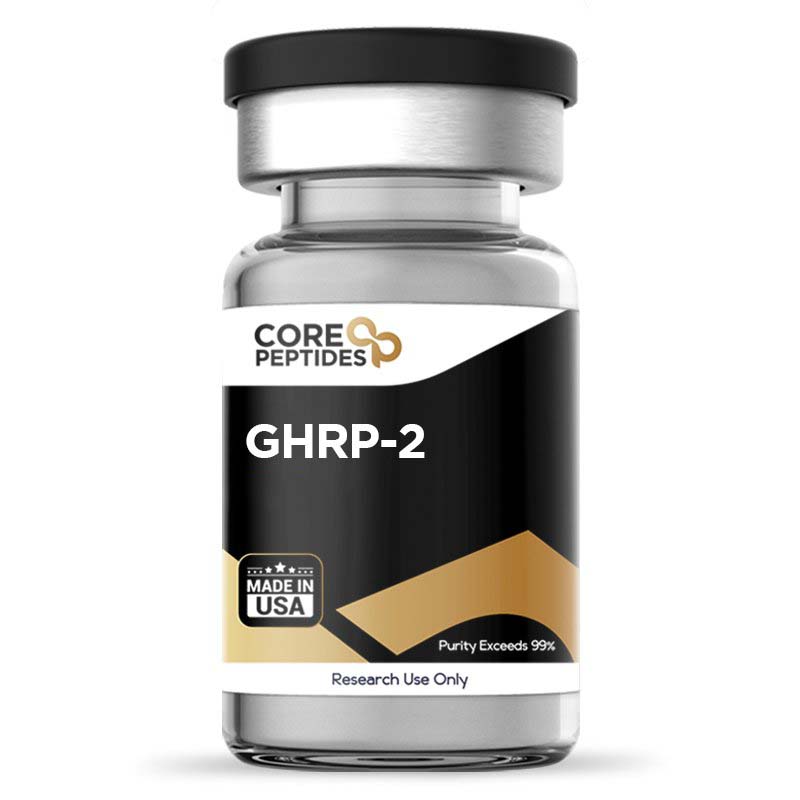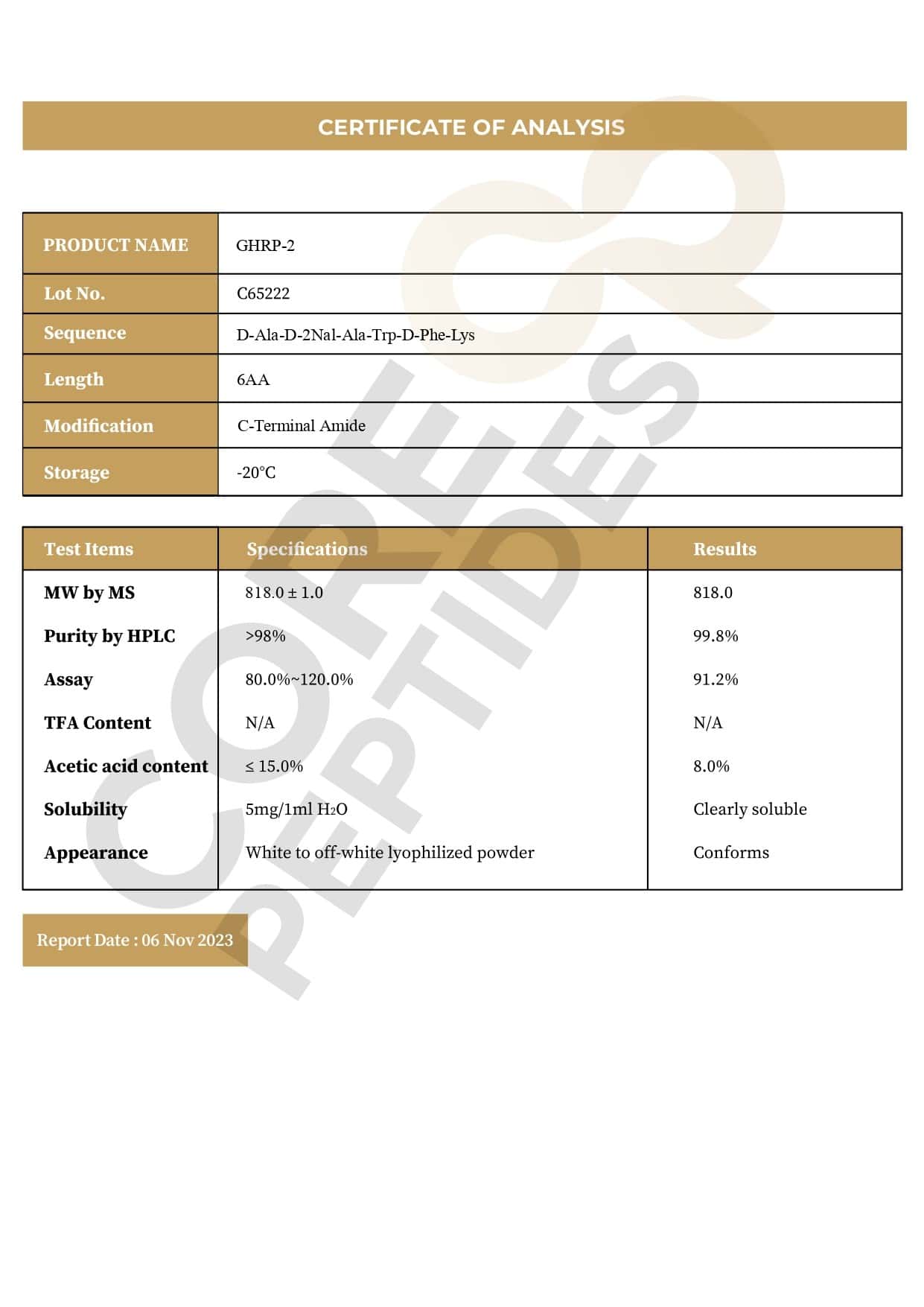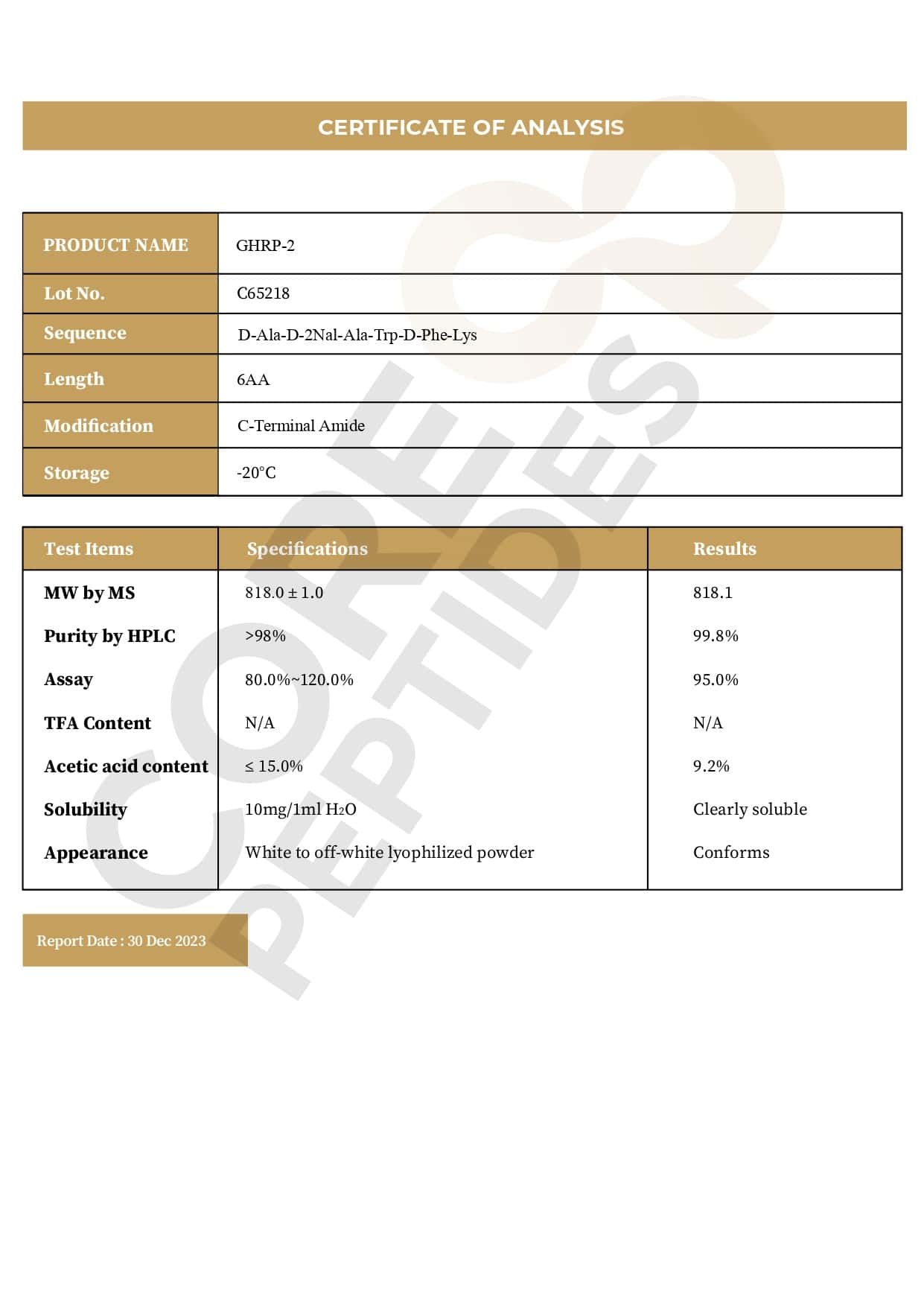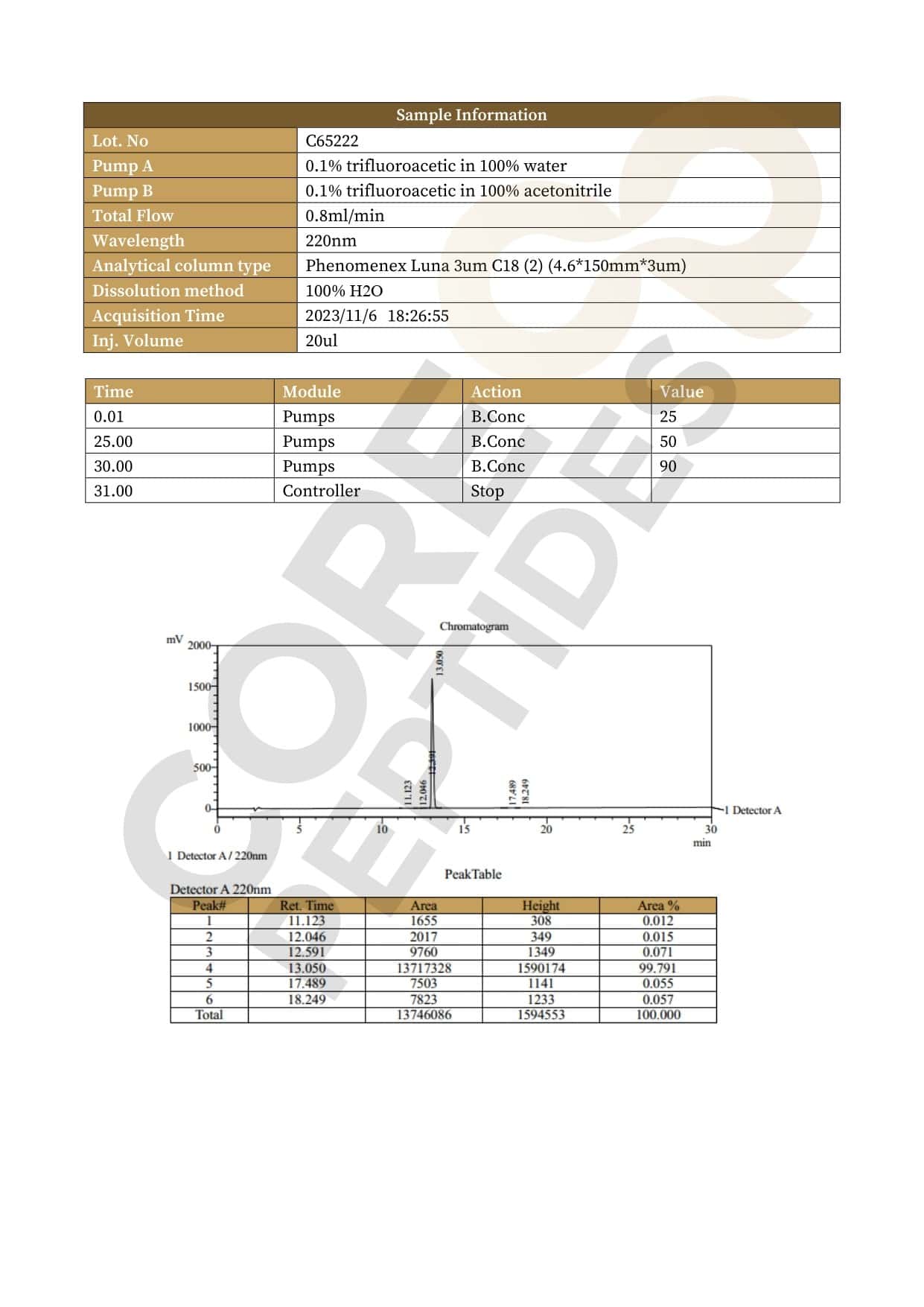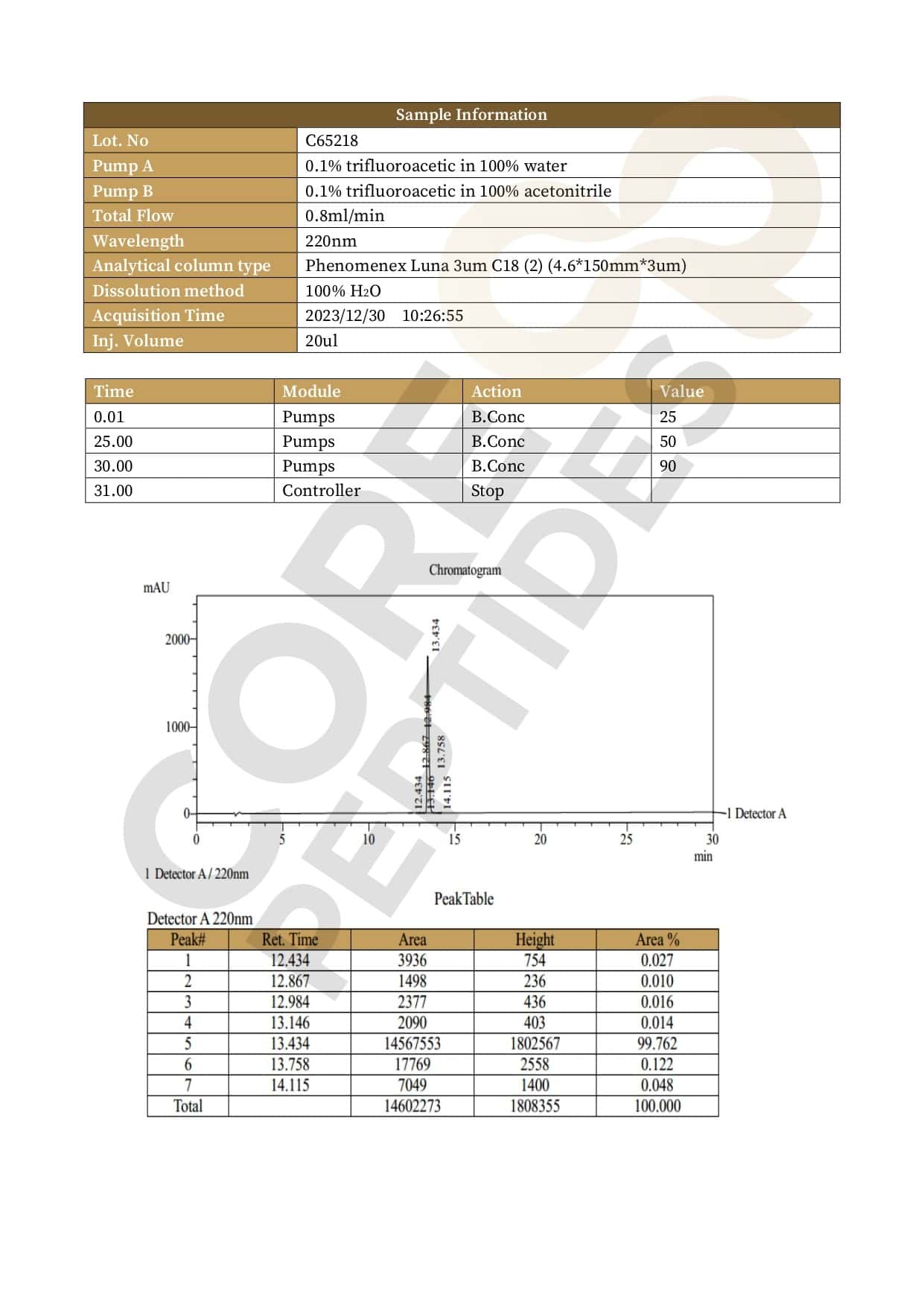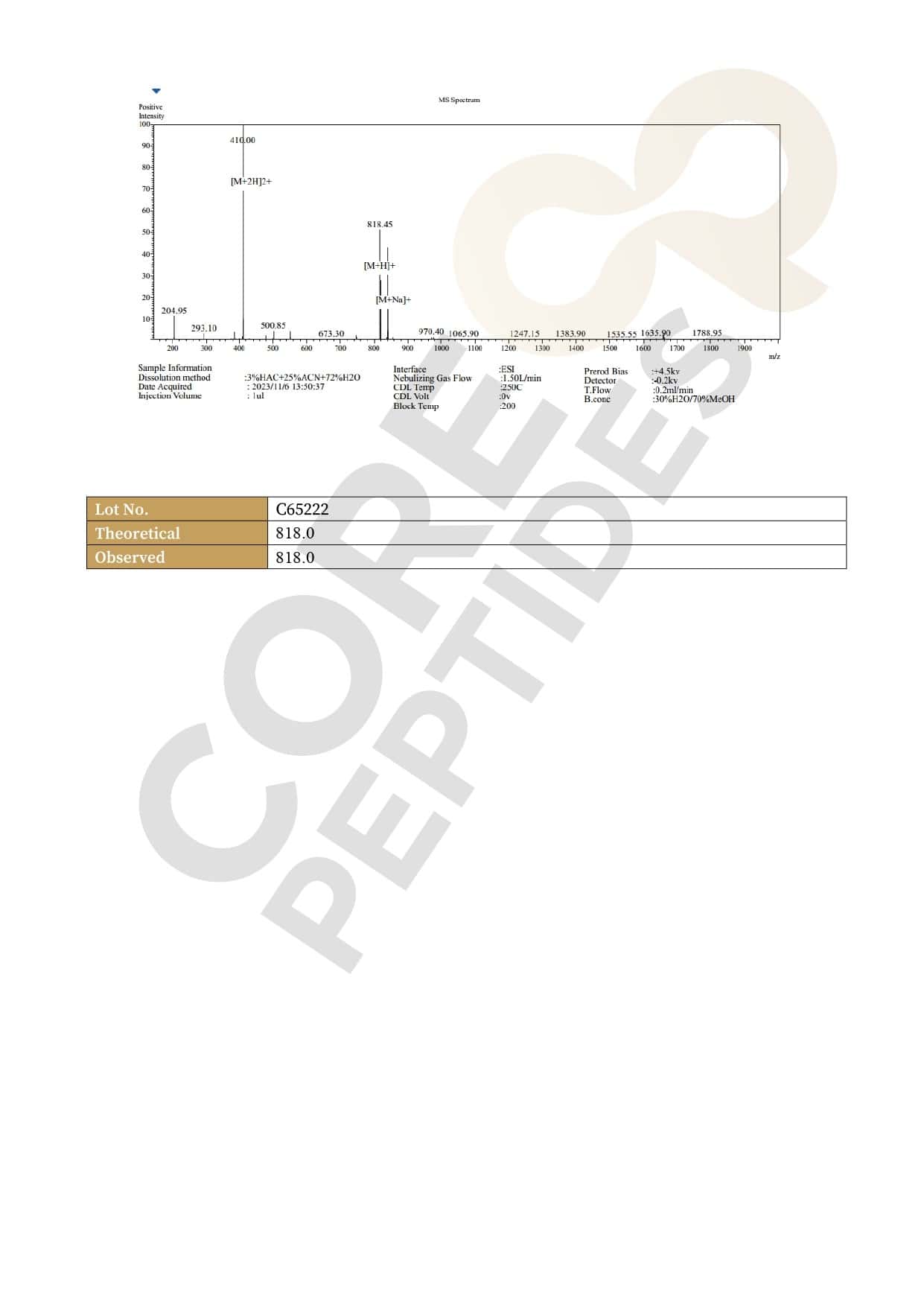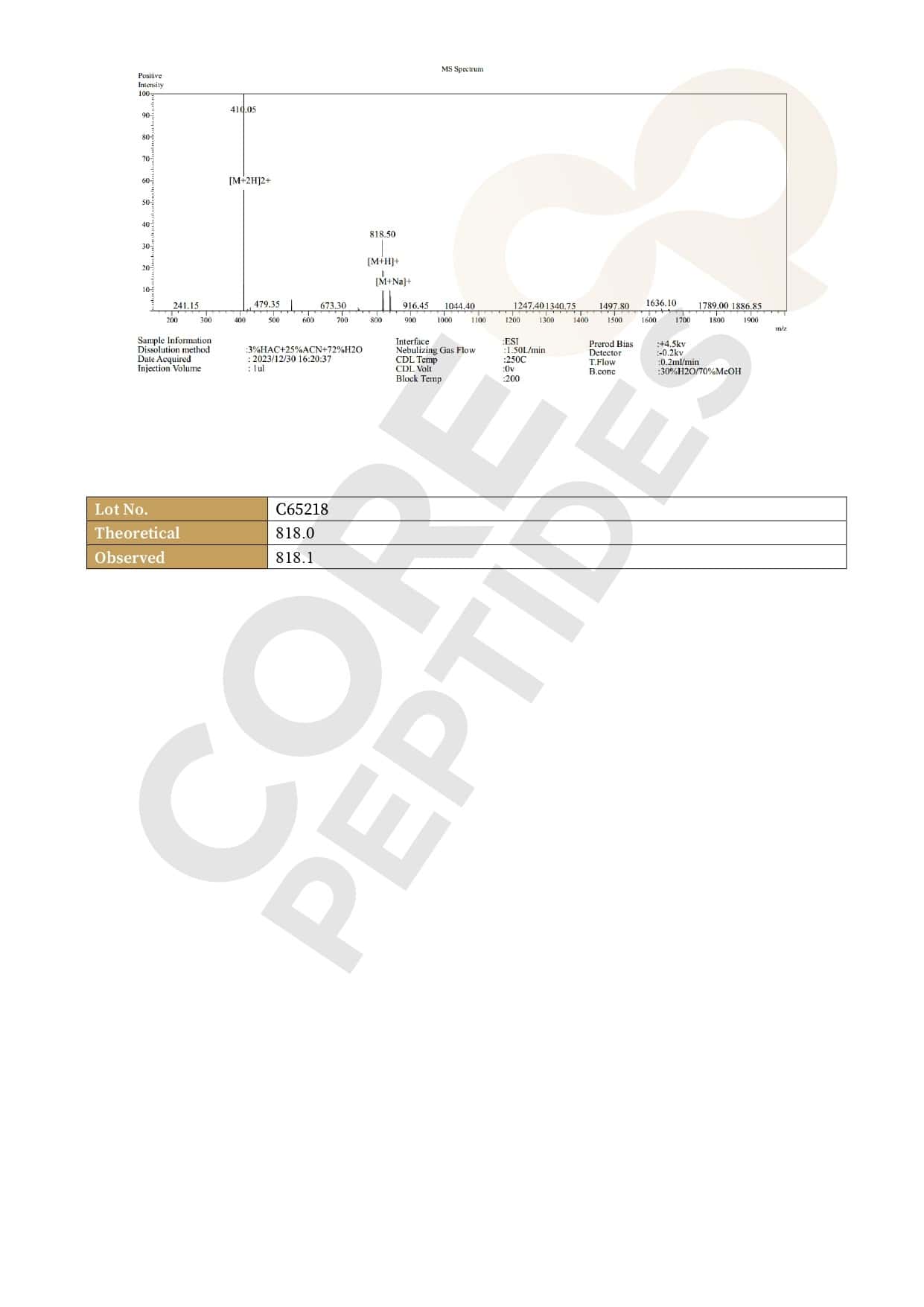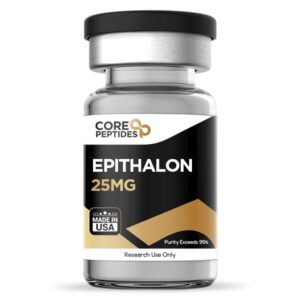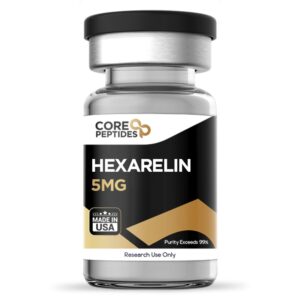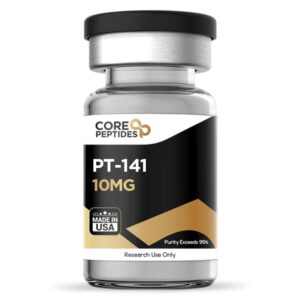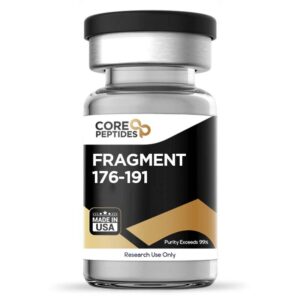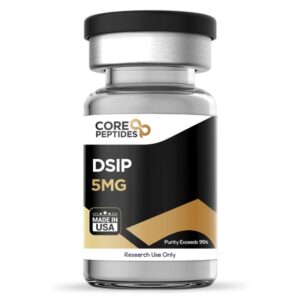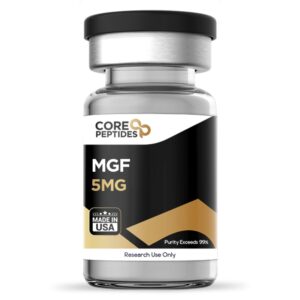GHRP-2 (5mg / 10mg)
$19.00 – $29.00
Size: 5mg / 10mg
Contents: GHRP-2
Form: Lyophilized powder
Purity: >99%
SKU: P-GHRP2
FREE Shipping on $200+ orders
FREE Bacteriostatic Water (30ml) on $200+ orders
Discount per Quantity
| Quantity | Discount | Price |
|---|---|---|
| 5 - 8 | 5% | $18.05 – $27.55 |
| 9 + | 10% | $17.10 – $26.10 |
GHRP-2 Peptide
GHRP-2 is a synthetic peptide made of five amino acids (pentapeptide) analogous to the endogenous neurotransmitter met-enkephalin.(1) Yet, the peptide appears to lack any neurotransmitter-like properties and instead appears to activate the receptors for the hormone ghrelin. Ghrelin is a naturally occurring hormone that is posited to regulate food intake.(11) Growth hormone-releasing peptide GHRP-2 may induce the secretion of growth hormone (GH) by apparently activating the ghrelin receptors on the pituitary gland, also termed as growth hormone secretagogue receptors (GHS-Rs).
Overview of GHRP-2 Mechanisms
Bovine studies have suggested that GHRP-2 peptide exhibits multifaceted impacts, but its main mechanism of action appears to involve the GHS-Rs. These receptors are naturally triggered by ghrelin and may be found in various parts of the nervous system and other tissues. In the nervous system, they are located in the hypothalamus and the pituitary, among other structures. When GHRP-2 appears to engage with GHS-Rs, it's believed that a structural transformation might be triggered upon attachment, possibly initiating intracellular signaling networks primarily mediated through G-proteins. The release of Gαq/11, a component of the G-proteins, might commence, potentially setting off subsequent signaling sequences. Phospholipase C (PLC) may split phosphatidylinositol 4,5-bisphosphate (PIP2) into secondary signaling molecules, IP3 and DAG (diacylglycerol). IP3 is thought to prompt the release of calcium ions. In contrast, DAG may activate protein kinase C (PKC), potentially heightening the signaling pathway and possibly facilitating the secretion of growth hormone from pituitary cells. Moreover, this process may also involve the activation of cyclic AMP (cAMP), which plays a crucial role in cellular signaling. Increasing cAMP levels may further enhance the signaling cascade, potentially boosting GH synthesis.(13)(14) Nevertheless, GHRP-2 appears to induce desensitization at these receptors immediately after exposure, potentially reducing sensitivity lasting a complete four hours before reversal.(5)
By apparently activating the GHS-Rs on other parts of the nervous system, GHRP-2 might trigger a series of cellular events leading to the enhanced synthesis of hunger-promoting neuropeptides, namely Neuropeptide Y (NPY) and Agouti-related peptide (AgRP). These peptides are thought to be integral to the regulation of energy balance and the control of appetite. At the same time, GHRP-2 is believed to possibly inhibit the secretion of the appetite-reducing hormone, melanocyte-stimulating hormone (α-MSH), thus shifting the equilibrium towards increased hunger and encouraging dietary intake. Moreover, GHRP-2 might affect the mesolimbic reward system, a neural pathway associated with regulating the craving for food, via the activation of GHSR-1a receptors. This action might theoretically heighten the drive for food consumption, potentially through the activation of cyclic adenosine monophosphate (cAMP) pathways, further implicating GHRP-2 in the modulation of feeding behavior and reward-based eating.
Chemical Makeup
Molecular Formula: C45H55N9O6
Molecular Weight: 817.97 g/mol
Other Known Titles: pralmorelin
Research and Clinical Studies
GHRP-2 Peptide and Growth Hormone Synthesis
This study(7) was conducted to understand the action of two synthetic GHRPs, GHRP-2 and Hexarelin (HEX), on growth hormone, prolactin, adrenocorticotropic hormone (ACTH), and cortisol concentrations. Two groups of various stages of mature development were evaluated, and both groups experienced a higher GH increase compared to the physiological increase induced by native growth hormone-releasing hormone (GHRH). Unfortunately, GHRP-2 also may induce an apparent increase in the levels of ACTH and cortisol.
Further studies have reported that exposure to GHRP-2 in laboratory settings may induce a significant increase in peak GH levels, mean pulsatile GH secretion by the anterior pituitary gland cells, and may potentially upregulate mediators of GH’s anabolic actions such as insulin-like growth factor-1 (IGF-1):
- In one trial, GHRP-2 was suggested to induce up to 181-fold higher spike in GH production by the anterior pituitary gland cells.(17)
- Another experiment posited that the peptide may induce a 47-fold increase in mean 2.5-hour pulsatile GH secretion by the anterior pituitary gland cells compared to placebo.(18)
- A third trial on prolonged GHRP-2 exposure reported that the peptide may have induced an apparent increase in GH levels between 3-fold and 5-fold. Moreover, IGF-1 levels apparently increased from an average of 100mcg/l at baseline to a plateau value of around 180mcg/l.(19)
GHRP-2 Peptide and Appetite
In one study,(2) two groups were evaluated, one following GHRP-2 exposure and the other with saline. They were then taken to a buffet meal to measure their food intake. The researchers reported that the GHRP-2 models ate an average of 36% more than the saline group, with each model reportedly exhibiting increased food intake when measured against their respective body weight. The researchers reported that the energy intake per kilogram of body weight increased up to 136.0±13.0 kJ/kg vs 101.3±10.5 kJ/kg for the placebo group. Furthermore, the GH levels also presented significant incremental increases in GHRP-2 models compared to saline. The levels of the hormone measured as “area under the curve” (AUC) increased up to 5550±1090 μg/L/240 min vs. 412±161 μg/L/240 min. The researchers concluded that “GHRP-2, like ghrelin, increases food intake, suggesting that GHRP-2 [may be] a valuable tool for investigating ghrelin effects on eating behavior.”
GHRP-2 Peptide and Muscle Tissues
Murine models of thermal injury have suggested that GHRP-2 may significantly decrease in proinflammatory markers such as IL-6 and E3 ubiquitin ligases (MuRF-1 and MAFbx), which are associated with muscle wasting in critical conditions. The authors also posited that the peptide may directly reduce total muscle protein breakdown in the experimental models, therefore suggesting a muscle-sparing action GHRP-2.(20) Case studies have also suggested that the peptide may induce muscle and weight gain.(21)
GHRP-2 Peptide and Antioxidative Actions
Studies indicate that GHRP-2 may display antioxidative potential, with researchers noting its possible affinity for CD36, a receptor thought to play a key role in capturing oxidized low-density lipoprotein (OxLDL). This interaction could potentially limit the cellular absorption of OxLDL, which is reputed to contribute to atherogenic processes. In experiments conducted on mouse models lacking the ApoE gene (ApoE(-/-)), GHRP-2 exposure over 12 weeks seemed to elevate circulating levels of IGF-I, with increases observed to be between 1.2 to 1.6 times the initial measurements. Additionally, a reduction of approximately 66% in circulating interferon-gamma levels was reported. Although GHRP-2's introduction did not appear to significantly alter the extent of atherosclerotic plaque coverage, it is suggested to have reduced superoxide production in the aorta, as indicated by dihydroethidium staining. Furthermore, GHRP-2 is reported to have notably decreased, by about 92%, the aortic gene expression of 12/15-lipoxygenase, and also diminished the aortic expressions of interferon-gamma and macrophage migration inhibitory factors. Observations in cultured aortic smooth muscle cells suggested that GHRP-2 may counter the production of peroxides triggered by OxLDL, prevent the suppression of the IGF-I receptor, and potentially block apoptosis. In macrophages exposed to OxLDL, GHRP-2 is hypothesized to reduce lipid accumulation, further illustrating its potential antioxidative and protective roles against proatherogenic agents.(15)
GHRP-2 Peptide and Inflammation
To further elucidate the potential action of GHRP-2 on oxidative stress and inflammation, a study on murine models with artificially induced acute lung injury suggested that exposure to GHRP-2 may reduce lung edema, neutrophil infiltration, and levels of pro-inflammatory cytokines. The peptide was also posited to have suppressed nuclear factor-kappaB activation, a major mediator of inflammation. The cascades that follow its activation often lead to tissue damage.(16)
GHRP-2 Peptide and GH Deficiency
The most common diagnostic tool for GH deficiency is the insulin tolerance test (ITT), which may cause contraindications. A study(8) aimed to explore the potential of GHRP-2 as a diagnostic resource for GH deficiency. The study evaluated research models first tested via ITT. Of these, the study indicated 77 models exhibited normal insulin tolerance and 58 exhibited GH peak levels of less than three. Post overnight fasting, all research models were presented GHRP-2. After 2 hours, their blood samples were collected and tested. Upon analysis, the researchers reported that the GH levels peaked after one hour of GHRP-2 in all cases. These results were reportedly reproducible upon repetition of the tests. An additional study(9) was conducted to research the diagnostic properties of GHRP-2 on still-developing research models of GH deficiency (GHD) in comparison to a conventionally-used compound. Research models of GHD were enrolled in this study, presented with at least one conventional compound, and later presented with GHRH and GHRP-2. All models were first given GHRP-2. When measured, the serum GH levels appeared to have significantly increased. Models who demonstrated a robust response to the peptide were then presented with GHRP-2 and GHRH in combination. All models exhibited an apparent positive response in their GH levels, according to the researchers.
Combination Studies with TRH and GnRH
This study(10) was conducted on research models of prolonged hypo-somatotropism, hypogonadism, or hypothyroid complications to evaluate the action of compounds of GHRP 2, Thyrotropin-releasing hormone (TRH), and Gonadotropin-releasing hormone (GnRH) with GHRP-2 alone and with GHRP-2 and TRH in combination. Over 5 days, one group was presented with a placebo, one group with GHRP-2 every hour, another group with GHRP-2 + TRH every hour, and the remaining group with GHRP-2 + TRH + GnRH every 90 minutes. Serum samples were collected on the first and last night of the study. After the results were analyzed, researchers suggested that the combination of GHRP-2 + GnRH + TRH induced the greatest apparent activation of growth hormones along thyroid stimulating hormone and luteinizing hormone axes, along with other possible metabolic effects. These actions were reported to be absent with GHRP-2 solo presentation and only partially seen with GHRP-2 and TRH combination.
GHRP 2 peptide is available for research and laboratory purposes only. Please review and adhere to our Terms and Conditions before ordering.
References:
- Garcia JM, Merriam GR, Kargi AY. Growth Hormone in Aging. In: Feingold KR, Anawalt B, Boyce A, et al., editors. Endotext. South Dartmouth (MA): MDText.com https://www.ncbi.nlm.nih.gov/books/NBK279163/
- Laferrère, Blandine et al. “Growth hormone releasing peptide-2 (GHRP-2), like ghrelin, increases food intake in healthy men.” The Journal of clinical endocrinology and metabolism vol. 90,2 (2005): 611-4. https://www.ncbi.nlm.nih.gov/pmc/articles/PMC2824650/
- Bowers CY. History to the discovery of ghrelin. Methods Enzymol. 2012;514:3-32. doi: 10.1016/B978-0-12-381272-8.00001-5. PMID: 22975043. https://pubmed.ncbi.nlm.nih.gov/22975043/
- Roh SG, He ML, Matsunaga N, Hidaka S, Hidari H. Mechanisms of action of growth hormone-releasing peptide-2 in bovine pituitary cells. J Anim Sci. 1997 Oct;75(10):2744-8. doi: 10.2527/1997.75102744x. PMID: 9331879. https://pubmed.ncbi.nlm.nih.gov/9331879/
- Asad Rahim, Stephen M. Shalet, in Growth Hormone Secretagogues, 1999. Does desensitization to growth hormone secretagogues occur? https://www.sciencedirect.com/topics/medicine-and-dentistry/pralmorelin
- Furuta S, Shimada O, Doi N, Ukai K, Nakagawa T, Watanabe J, Imaizumi M. General pharmacology of KP-102 (GHRP-2), a potent growth hormone-releasing peptide. Arzneimittelforschung. 2004;54(12):868-80. doi: 10.1055/s-0031-1297042. PMID: 15646371. https://pubmed.ncbi.nlm.nih.gov/15646371/
- Emanuela Arvat, Lidia Di Vito, Barbara Maccagno, Fabio Broglio, Muni F Boghen, Romano Deghenghi, Franco Camanni, Ezio Ghigo, Effects of GHRP-2 and Hexarelin, Two Synthetic GH-Releasing Peptides, on GH, Prolactin, ACTH and Cortisol Levels in Man. Comparison with the Effects of GHRH, TRH and hCRH, Peptides, Volume 18, Issue 6, 1997, Pages 885-891, ISSN 0196-9781, https://doi.org/10.1016/S0196-9781(97)00016-8
- Chihara K, Shimatsu A, Hizuka N, Tanaka T, Seino Y, Katofor Y; KP-102 Study Group. A simple diagnostic test using GH-releasing peptide-2 in adult GH deficiency. Eur J Endocrinol. 2007 Jul;157(1):19-27. doi: 10.1530/EJE-07-0066. https://pubmed.ncbi.nlm.nih.gov/17609397/
- Pihoker C, Middleton R, Reynolds GA, Bowers CY, Badger TM. Diagnostic studies with intravenous and intranasal growth hormone-releasing peptide-2 in children of short stature. J Clin Endocrinol Metab. 1995 Oct;80(10):2987-92. https://pubmed.ncbi.nlm.nih.gov/7559885/
- Van den Berghe G, Baxter RC, Weekers F, Wouters P, Bowers CY, Iranmanesh A, Veldhuis JD, Bouillon R. The combined administration of GH-releasing peptide-2 (GHRP-2), TRH and GnRH to men with prolonged critical illness evokes superior endocrine and metabolic effects compared to treatment with GHRP-2 alone. Clin Endocrinol (Oxf). 2002 May;56(5):655-69. https://pubmed.ncbi.nlm.nih.gov/12030918/
- GHRP 2, GPA 748, Growth Hormone-Releasing Peptide 2, KP-102 D, KP-102 LN, KP-102D, KP-102 LN. https://link.springer.com/article/10.2165/00126839-200405040-00011#
- Phung LT, Sasaki A, Lee HG, Vega RA, Matsunaga N, Hidaka S, Kuwayama H, Hidari H. Effects of the administration of growth hormone-releasing peptide-2 (GHRP-2) orally by gavage and in feed on growth hormone release in swine. Domest Anim Endocrinol. 2001 Jan;20(1):9-19. https://pubmed.ncbi.nlm.nih.gov/11164330/
- Yin, Y., Li, Y., & Zhang, W. (2014). The growth hormone secretagogue receptor: its intracellular signaling and regulation. International journal of molecular sciences, 15(3), 4837–4855. https://doi.org/10.3390/ijms15034837
- Sinha, D. K., Balasubramanian, A., Tatem, A. J., Rivera-Mirabal, J., Yu, J., Kovac, J., Pastuszak, A. W., & Lipshultz, L. I. (2020). Beyond the androgen receptor: the role of growth hormone secretagogues in the modern management of body composition in hypogonadal males. Translational andrology and urology, 9(Suppl 2), S149–S159. https://doi.org/10.21037/tau.2019.11.30
- Titterington JS, Sukhanov S, Higashi Y, Vaughn C, Bowers C, Delafontaine P. Growth hormone-releasing peptide-2 suppresses vascular oxidative stress in ApoE-/- mice but does not reduce atherosclerosis. Endocrinology. 2009 Dec;150(12):5478-87. doi: 10.1210/en.2009-0283. Epub 2009 Oct 9. PMID: 19819949; PMCID: PMC2795722.
- Li, G., Li, J., Zhou, Q., Song, X., Liang, H., & Huang, L. (2010). Growth hormone releasing peptide-2, a ghrelin agonist, attenuates lipopolysaccharide-induced acute lung injury in rats. The Tohoku journal of experimental medicine, 222(1), 7–13. https://doi.org/10.1620/tjem.222.7
- Veldhuis, J. D., Keenan, D. M., Bailey, J. N., Adeniji, A. M., Miles, J. M., & Bowers, C. Y. (2009). Novel relationships of age, visceral adiposity, insulin-like growth factor (IGF)-I and IGF binding protein concentrations to growth hormone (GH) releasing-hormone and GH releasing-peptide efficacies in men during experimental hypogonadal clamp. The Journal of clinical endocrinology and metabolism, 94(6), 2137–2143. https://doi.org/10.1210/jc.2009-0136
- Veldhuis, J. D., & Keenan, D. M. (2008). Secretagogues govern GH secretory-burst waveform and mass in healthy eugonadal and short-term hypogonadal men. European journal of endocrinology, 159(5), 547–554. https://doi.org/10.1530/EJE-08-0414
- Bowers, C. Y., Granda, R., Mohan, S., Kuipers, J., Baylink, D., & Veldhuis, J. D. (2004). Sustained elevation of pulsatile growth hormone (GH) secretion and insulin-like growth factor I (IGF-I), IGF-binding protein-3 (IGFBP-3), and IGFBP-5 concentrations during 30-day continuous subcutaneous infusion of GH-releasing peptide-2 in older men and women. The Journal of clinical endocrinology and metabolism, 89(5), 2290–2300. https://doi.org/10.1210/jc.2003-031799
- Sheriff, S., Joshi, R., Friend, L. A., James, J. H., & Balasubramaniam, A. (2009). Ghrelin receptor agonist, GHRP-2, attenuates burn injury-induced MuRF-1 and MAFbx expression and muscle proteolysis in rats. Peptides, 30(10), 1909–1913. https://doi.org/10.1016/j.peptides.2009.06.029
- Sigalos, J. T., & Pastuszak, A. W. (2018). The Safety and Efficacy of Growth Hormone Secretagogues. Sexual medicine reviews, 6(1), 45–53. https://doi.org/10.1016/j.sxmr.2017.02.004
Certificate of Analysis (5mg)
Certificate of Analysis (10mg)
High Performance Liquid Chromatography (5mg)
High Performance Liquid Chromatography (10mg)

